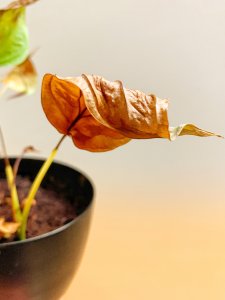How to Tell if Your Plant Is Sick or Dying

What are those brown spots on those leaves? Should I cut off sickly-looking leaves? What does my plant need? Can my plant recover? These are all questions that you may be asking yourself right now.
You’re understandably worried about your plant showing signs of distress, so below, you’ll find a quick guide to help you identify whatever issues are plaguing your plants before they succumb.
Signs Your Plant is Dying or Sick
Plants are talkative, in a way. Because they can be quite sensitive to watering, soil acidity, light conditions, humidity, pest infestations and a broad range of factors, they’ll tell you when something is bothering them. Keep an eye out for:
- Yellowing or browning on the leaves
- Wilting or drooping leaves
- Leaves falling off
- Roots visible on the surface of the soil or coming through drainage holes
- Brown or black spots
- Flowers blooming and then falling off soon after
- The presence of gnats
- Visible fungus on the leaves or the soil surface
These symptoms usually mean your plant is asking you to take action.
Can Sick Plants Recover?
It depends. Sometimes plants can be resilient and bounce back to their original health after proper measures are taken. Unfortunately, sometimes plants are not able to bounce back, despite all your best efforts. One thing to remember is that if there is still any green coloration left on your plant, you may still be able to bring them back from the brink.
That said, a simple repotting can be all that is needed to save your plant. A larger pot or planter with fresh, healthy soil can sometimes be enough to save them. If your leaves are dry and crunchy at the ends, you may be underwatering your plant. Conversely, if your plant’s leaves are brown or yellow, and the soil is still moist days after watering, you may be overwatering it. Delay your watering for a week or two to allow the soil and roots to dry out before adding more. You may also want to consider rotating your plants so that it gets light/sun from all angles.
3 Common Plant Diseases
Some fungi can form symbiotic relationships with plants and soil. Some, however, destroy your plant from above or below the soil. The following are three of the most common plant diseases that may be afflicting your plant:
Powdery Mildew
This kind of fungus looks like white mildew or a dusty white coating on the underside of your plant’s leaves, and is usually caused by prolonged wetness.
Root Rot or Thielaviopsis
Usually caused by overwatering and poor drainage, root rot looks like mushy, black, deadened roots. Healthy roots look tan and feel firm. Early signs of root rot include wilting and yellowing leaves.
Gray Mold or Botrytis
Usually found in the wounds of plants, it can look like brown or gray rot around the wound site. That said, it can attack any part of your plant. Look for fuzzy, gray mold.
Visit Fairview Garden Center for Expert Advice
Each plant has unique characteristics and needs to stay healthy and thriving. Let our team guide you to the best solution to save or revive your sick or dying plants. We have a wide variety of solutions available at our store for your purchase, and we encourage you to bring in your plants when you come see us!




